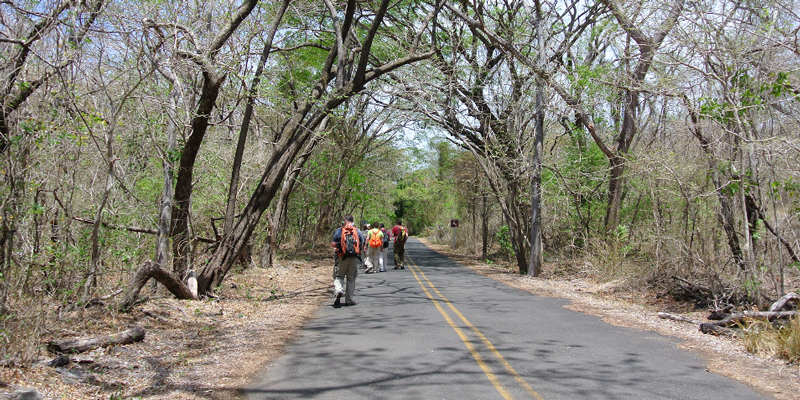A special section in Biotropica edited by Jennifer Powers gives a window into one of the most famous research areas in the tropics.

University of Minnesota undergraduates on a field course in Santa Rosa, 2013 (photo credit: Jennifer Powers)
Jennifer Powers, professor in Ecology, Evolution and Behavior and Plant and Microbial Biology, serves as editor-in-chief for the journal Biotropica. She recently oversaw a special section in Biotropica featuring nine articles penned by forty contributing authors, the issue synthesizes decades of work from Área de Conservación Guanacaste (ACG), a unique conservation area in northwestern Costa Rica.
The area is home to tropical dry forests which are characterized by months of heavy rain, followed by months of no rain. Many trees lose all of their leaves during this dry spell. ACG allows ecologists to ask questions across gradients of land-use history, soil type, altitude, forest type and seasons. In a relatively small area, researchers can leverage vast gradients and tackle a wide range of questions. This makes it an idyllic place to study.
For any editor, wrangling a special issue is a herculean effort. For Powers, it’s also personal. As a postdoc she worked in the area and decades later, she still partners with local community members to carry out research. The special issue provides perspectives on the long-term research and public engagement programs.
“Área de Conservación Guanacaste is widely considered one of the most successful examples of tropical restoration, and this special issue highlights the contributions of long-term research, conservation and education,” says Powers.
We caught up with Powers for a Q&A to learn more about ACG.
Q: What makes the conservation area unique?
A: There are several aspects that set this place apart from other conservation areas in the world. One is where it is located. The park is in an area that’s culturally significant to Costa Ricans. In the 1850s, Costa Ricans held off the U.S. “filibuster” William Walker and his mercenary army, who sought to make Costa Rica an outpost for slaveholders. The headquarters of the park is the restored ranch house, which to Costa Ricans is known as “La Casona.” It’s unique to have an area that’s both culturally and ecologically significant.
Q: How did ACG start?
A: Originally the aim was to restore the dry forest ecosystem. Using a variety of management techniques, they worked to convert ranchlands and failing agricultural plantations back to dry tropical forests, starting in the 1970s. Pretty quickly scientists realized that they needed to expand this scope to include other ecosystems, including humid forests and mangroves.
Q: Why is education a significant component to ACG’s mission?
A: The goal of ACG is to conserve the biodiversity in perpetuity. ACG leaders realized early on that the only way to do that was to involve the local community. If community members value ACG, it’s more likely to continue being protected. The best way to have people value it is to know it. Given that, ACG started a biological education program 30 years ago. It involves around 50 schools in the province and centers education in the curriculum for 4-6 grade students. The students visit the conservation area a dozen times over the three year program.
Q: How has your work evolved since working at ACG?
A: The collaborative group of researchers and the long-term nature of experiments makes my research stronger. Sometimes it takes ten years of working in an area to even think that you know what the questions are. Then, once you learn more about an area, new questions present themselves and my work evolves again. It’s great to work in a place where my work can evolve as new questions present themselves.
Q: What’s an example of a new question that arose?
A: One great example is understanding what trees are better choices for restoration projects that are prone to intense drought. We didn’t have this particular question in mind when we started collecting years of demography on trees in an area. However, when strong El Nino came in 2015, a large swath of trees died. We were able to look back at our data and learn that certain species did not fare as well. This finding led us to set up a more rigorous rainfall exclusion experiment to gauge what trees are drought tolerant. At ACG, research and conservation are tightly linked. And it’s rewarding to see those linkages naturally occur.
Q: What were your contributions to the special issue?
A: In addition to wrangling the authors, themes and deadlines, I also co-wrote a piece with my colleague Dr. Catherine Hulshof, an assistant professor at Virginia Commonwealth University. We summarized 40 years of plant ecology at ACG. We highlight the main themes, approaches researchers took, lessons learned and new horizons of plant ecology research. Catherine dug into the history of plant ecology and made a lot of connections that highlight how the history of plant ecology at ACG echoes the history of plant ecology globally. We framed it in terms of the gradients at ACG. It is a great place to use the gradient approach to study plant ecology.
— Claire Wilson